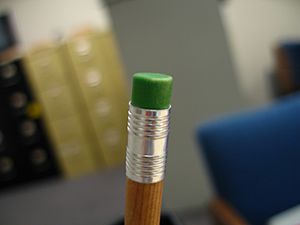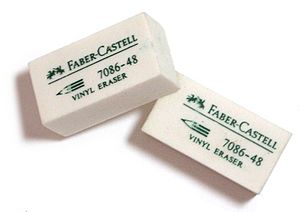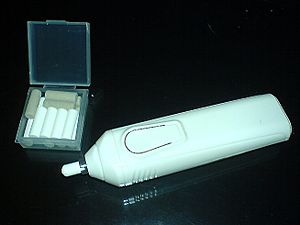Eraser facts for kids

An eraser is a handy tool, often made from rubber, that helps you remove marks made by pencils or certain types of pens. Some erasers are even attached to the end of a pencil! You can also find erasers made of felt that are used to wipe away chalk marks from a blackboard.
When you rub an eraser over a mistake, it slowly clears the mark away. As you use an eraser, it creates tiny bits of dust or "debris." This dust is usually black because it picks up the pencil marks. Some erasers make a lot of dust, while others create dust that sticks together. Good quality erasers are often soft and erase easily. Harder erasers might need more rubbing to do the job. The classic pink eraser is great for small, light errors. Thicker, white erasers are often better for bigger or darker marks.
Contents
Different Types of Erasers
There are many kinds of erasers, each designed for different uses.
Pencil or Cap Erasers
These erasers were first made from natural rubber. Today, they are often made from a cheaper material called SBR. They contain mineral fillers and a rough material like pumice. They also have a plasticizer, such as vegetable oil, to make them flexible. These erasers are quite firm so they can stay attached to a pencil. They are often colored pink.
Artist's Gum Erasers

The name "Artgum" was first used in 1903. These erasers were originally made from oils like corn oil that were treated with sulfur dichloride. Now, they might be made from natural or man-made rubber, or vinyl. Artist's gum erasers are very soft but still keep their shape. They tend to crumble as you use them. This type of eraser is great for cleaning large areas without harming the paper. However, they are so soft that they can be hard to use for small details. The graphite from your drawing gets carried away in the crumbles. This leaves the eraser clean, but creates a lot of eraser bits. You need to carefully brush away these bits, as they are coated with graphite and could make new marks. Art gum erasers are usually tan or brown, but some are blue.
Vinyl Erasers
Good quality vinyl erasers are often called "plastic" erasers. They are softer and do not scratch the paper. They also erase more cleanly than regular rubber erasers. This is because the graphite does not stick to the eraser as much. Instead, it is absorbed by the discarded vinyl scraps. Since they are soft and gentle, they are less likely to damage canvas or paper. Engineers often prefer these erasers for technical drawings. They are gentle on paper and cause less smudging. Vinyl erasers are often white and come in many shapes. You can also find very cheap erasers made from soft vinyl in fun, decorative shapes.
Kneaded Erasers
Kneaded erasers feel like soft clay or putty. Many artists use them as a basic tool. You can pull them into a point to erase small areas or fine details. You can also mold them to create textures or use them to gently lighten lines or shading without completely erasing them. Over time, they become less effective as they pick up particles from your drawings and the air. They are not good for erasing large areas because they change shape easily when you rub hard.
Poster Putty
Poster putty is a soft, moldable putty often sold with school supplies. It comes in many colors and under different brand names. It is meant to stick posters to walls without causing damage. Poster putty works much like a kneaded eraser, but it is stickier. It doesn't really "erase" but rather lifts particles of graphite, charcoal, or pastel directly from a drawing. This means it usually doesn't smudge or damage your artwork. By repeatedly touching the putty to a drawing, you can gradually lighten your work in a controlled way. You can shape poster putty into fine points or sharp edges for detailed work. You can also roll it across a surface to create visual textures. Poster putty loses its stickiness over time as it collects debris and oils from your skin.
Electric Erasers
The electric eraser was invented in 1932 by Arthur Dremel. It uses a motor to spin a replaceable cylinder of eraser material. The fast spinning motion means you don't need to press as hard. This helps prevent damage to the paper. At first, they used standard pencil eraser rubber. Later, better-performing vinyl was used. Dremel later created a whole line of hand-held rotary power tools.
Fibreglass Erasers
A fibreglass eraser is a bundle of very thin glass fibers. It can be used for erasing and other tasks that need a bit of scratching. These erasers are usually shaped like a pen. They have a replaceable insert with glass fibers that wear down as you use them. The fibers are very hard. Besides removing pencil and pen marks, these erasers are used for cleaning parts on electronic circuit boards. This helps with soldering. They can also remove rust and have many other uses. For example, a fibreglass eraser was used to prepare an archaeological fossil that was stuck in very hard limestone.
Other Erasers
Felt chalkboard erasers are used to wipe away chalk marks from a chalkboard. Chalk writing leaves light-colored particles that are not strongly attached to a dark surface. You can rub them off with a soft material like a rag. Chalkboard erasers are much larger than pencil erasers. They have a block of plastic or wood with a layer of felt on one side. You hold the block and rub the felt against the writing, which easily wipes it off. Chalk dust is released, and some sticks to the eraser until you clean it, usually by hitting it against a hard surface.
Different types of erasers are used for whiteboards, depending on the board and the ink. Some ballpens and permanent markers come with special erasers. These erasers are only meant to remove the ink from that specific writing tool. Sometimes, they work by making the ink stick more strongly to the eraser material than to the surface it was written on.
Images for kids
See also
 In Spanish: Goma de borrar para niños
In Spanish: Goma de borrar para niños





